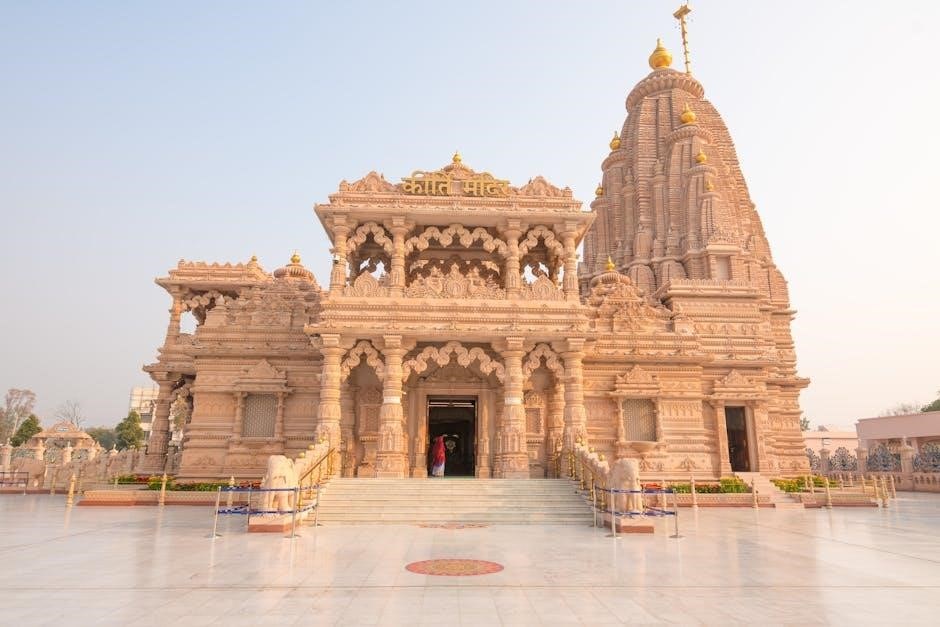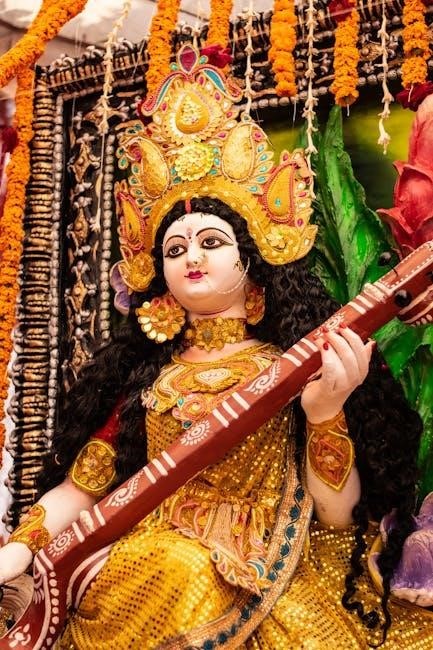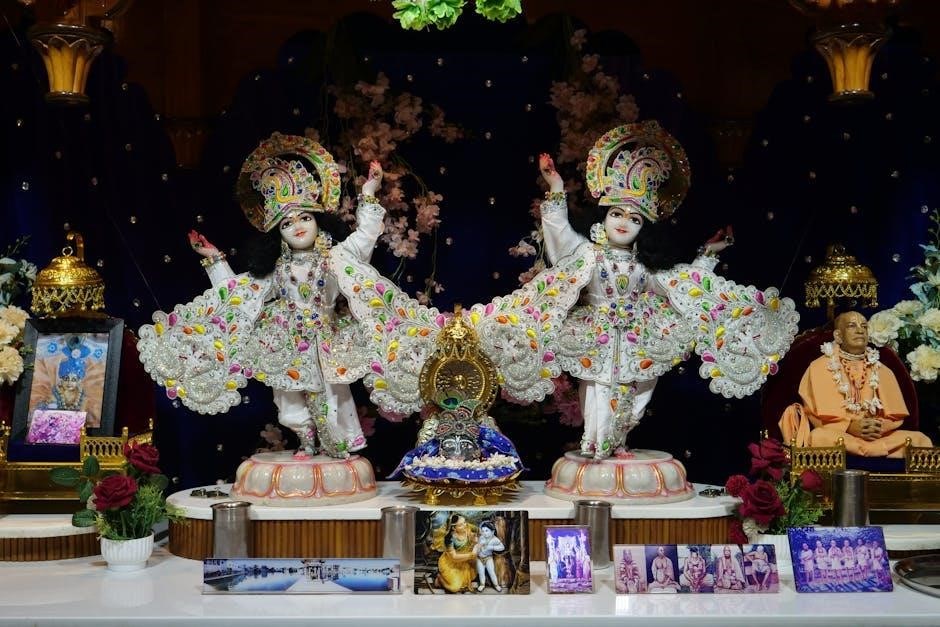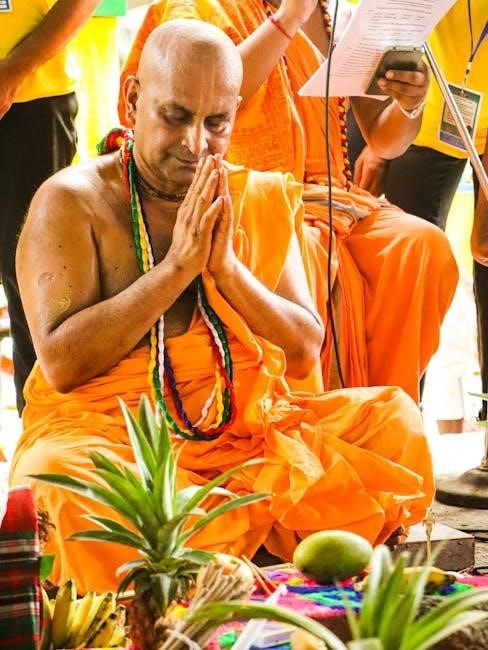Vishnu Sahasranama is a revered Sanskrit hymn from the Mahabharata, comprising 1000 divine names of Lord Vishnu, symbolizing His universal supremacy and divine attributes, central to Hindu worship and spirituality.
1.1 Overview of Vishnu Sahasranama
Vishnu Sahasranama is a sacred Sanskrit hymn from the Mahabharata, written by Veda Vyasa. It consists of 1000 names of Lord Vishnu, each highlighting His divine attributes and universal supremacy. Also known as a namavali, it is widely used in Hindu worship, meditation, and spiritual growth. The text is divided into shlokas, making it easy to recite and chant, and is considered a powerful tool for connecting with the divine, fostering devotion, and seeking spiritual enlightenment.

1.2 Historical Significance and Origin
Vishnu Sahasranama originates from the Mahabharata, specifically the Anushasana Parva, authored by the revered sage Veda Vyasa. This sacred text has been a cornerstone of Hindu spirituality for centuries, reflecting deep philosophical insights and devotion to Lord Vishnu. Its historical significance lies in its composition during ancient India’s epic period, making it a timeless hymn that has influenced Hindu thought, worship, and culture profoundly, remaining central to Vaishnavism and Hindu religious practices.
1.3 Importance in Hindu Scripture and Worship
Vishnu Sahasranama holds paramount significance in Hindu scripture as a meditation tool and divine worship aid. Chanting it is believed to offer spiritual purification, emotional solace, and mental clarity. It is integral to Vaishnavite traditions, often recited in temples and homes during rituals and daily devotion. Its verses encapsulate profound philosophical truths, making it a cornerstone of Hindu worship, fostering a deep connection with the divine and enhancing spiritual growth and inner peace among devotees.

Structure and Composition
The Vishnu Sahasranama is structured as 108 shlokas in Anushtup meter, each name describing Vishnu’s attributes, composed in Sanskrit for spiritual recitation and contemplation, maintaining its sacred essence.
2.1 The 1000 Names of Vishnu
The Vishnu Sahasranama comprises 1000 divine names of Lord Vishnu, each signifying His unique attributes and divine qualities. These names are organized into 108 shlokas, written in the Anushtup meter, reflecting His universal supremacy and omnipresence. Each name embodies spiritual significance, offering insights into Vishnu’s role as the protector and sustainer of the universe. The hymn, originating from the Mahabharata’s Anushasana Parva, is a sacred Sanskrit composition, revered for its profundity and used in daily worship and meditation to connect with the divine essence of Vishnu.
2.2 Sanskrit Script and Its Significance
The Vishnu Sahasranama is written in the sacred Sanskrit script, a language revered for its spiritual and phonetic precision; The script’s intricate structure is believed to carry divine energy, making it ideal for chanting and meditation. Its meter and rhythm enhance the hymn’s potency, allowing devotees to connect deeply with Lord Vishnu’s essence. The PDF versions of the Sahasranama preserve this sacred script, ensuring its authenticity and accessibility for modern worshippers seeking spiritual enlightenment and harmony through its recitation.
2.3 Division into Shlokas and Verses
The Vishnu Sahasranama is meticulously divided into 108 shlokas, each structured in the Anushtup meter, enhancing its rhythmic and devotional impact. These verses are further grouped into sections, facilitating easy recitation and meditation. The division reflects ancient Vedic poetic traditions, ensuring harmony and flow. PDF versions retain this structure, often with transliteration and translation, making the sacred text accessible for spiritual practice and study, while preserving its original sanctity and aesthetic appeal for devotees worldwide.

Benefits of Chanting Vishnu Sahasranama
Chanting Vishnu Sahasranama brings spiritual enlightenment, mental peace, and emotional well-being. It is believed to ward off negativity, enhance devotion, and foster a deeper connection with the divine.
3.1 Spiritual and Meditative Benefits
Chanting Vishnu Sahasranama is a powerful spiritual practice that fosters deep meditation, mental clarity, and inner peace. It helps devotees connect with Lord Vishnu, promoting a sense of divine harmony and spiritual growth. The rhythmic recitation of the 1000 names calms the mind, allowing for focused contemplation and a stronger bond with the Almighty. Regular chanting is believed to enhance spiritual awareness, purify the soul, and guide one toward a path of righteousness and self-realization, as mentioned in ancient scriptures like the Mahabharata.
3.2 Emotional and Mental Well-being
Reciting Vishnu Sahasranama brings emotional balance and mental tranquility, calming the mind and dispelling negative emotions. The divine names evoke feelings of devotion, fostering positivity and resilience. Regular chanting helps reduce stress, anxiety, and sorrow, promoting a sense of inner peace and stability. It cultivates mindfulness, allowing individuals to focus on the present and trust in divine guidance, ultimately enhancing emotional well-being and mental clarity through its soothing and uplifting effects.
3.3 Mythological and Scriptural References
Vishnu Sahasranama originates from the Mahabharata, specifically the Anushasana Parva, where Bhishma recites it to Yudhishthira. This scriptural text is deeply rooted in Hindu mythology, highlighting Vishnu’s divine attributes and universal supremacy. The hymn is often referenced in ancient commentaries by scholars like Adi Shankara and Parasara Bhattar, reinforcing its spiritual significance. Its inclusion in sacred scriptures underscores its role as a powerful tool for devotion, meditation, and spiritual growth, making it a cornerstone of Vaishnavite tradition and worship.

The Vishnu Sahasranama Sanskrit PDF is widely available online, offering the sacred hymn in its original script. Trusted sources include SanskritDocuments.org and Ishwar Ashram Trust, ensuring authenticity and readability for devotees.
4.1 Availability of PDF Versions Online
Vishnu Sahasranama in Sanskrit PDF is readily available online through trusted platforms like SanskritDocuments.org and Ishwar Ashram Trust. These sources provide free downloads, ensuring easy access for devotees. The PDFs often include the original Sanskrit text, transliterations, and sometimes English translations, making them versatile for both spiritual and academic purposes. Popular files like “Vishnu Sahasranama Stotram” and “Sree Vishnu Sahasra Nama Stotram” are frequently updated, offering high-quality versions for personal use and worship.
4.2 Popular Sources for Download

Devotees can download Vishnu Sahasranama in Sanskrit PDF from reputable websites such as SanskritDocuments.org and Archive.org. Additionally, platforms like Google Drive and Swami Krishnananda.org offer free access to these files. Many sources provide versions with transliterations and translations, catering to diverse needs. These platforms ensure that the sacred text remains accessible for spiritual practices and scholarly research, maintaining its sanctity and usability for a global audience seeking divine connection through this ancient hymn.
4.3 Features of the Sanskrit PDF Version
The Sanskrit PDF version of Vishnu Sahasranama often includes the original text with diacritical marks for accuracy. Many versions provide transliterations and English translations, making it accessible to non-Sanskrit speakers. Some PDFs feature commentaries by scholars like Adi Shankara and Parasara Bhattar, offering deeper insights. The files are typically well-formatted for readability and include introductory sections explaining the significance and benefits of chanting. These features make the PDF a valuable resource for both spiritual practice and academic study.

How to Download and Use the PDF
Vishnu Sahasranama Sanskrit PDFs are freely available online. Download from trusted sites like Sanskritdocuments.org or Ishwar Ashram Trust. Recite with concentration for spiritual benefits and clarity.
5.1 Step-by-Step Download Guide
Visit trusted websites like sanskritdocuments.org or Ishwar Ashram Trust. Search for “Vishnu Sahasranama Sanskrit PDF.” Click the download link, save the file, and open it for reading or printing. Ensure the source is reliable for authenticity. Many versions are free and easily accessible, making it simple to incorporate into daily worship or study. Always verify the source for a genuine and complete document to ensure a meaningful spiritual experience.
5.2 Tips for Effective Recitation
For effective recitation of Vishnu Sahasranama, understand the meaning of each name to enhance spiritual focus. Practice proper pronunciation using Sanskrit guides or audio resources like Swami Krishnananda’s chanting. Maintain concentration and a calm, pure mind. Recite regularly, ideally during early morning hours, for consistency. Use the Sanskrit PDF for clear text visibility. Chant with devotion, respecting the divine attributes of Lord Vishnu. This ensures a profound spiritual experience and connection with the divine essence embodied in the Sahasranama.
5.3 Incorporating it into Daily Worship
Incorporate Vishnu Sahasranama into daily worship by reciting it during morning or evening prayers. Use the Sanskrit PDF for accurate pronunciation and understanding. Offer flowers or incense while chanting to enhance devotion. Integrate it into rituals or ceremonies for spiritual growth. Regular recitation fosters inner peace and divine connection, making it a meaningful part of daily worship practices. This sacred text is a powerful tool for worship, reflection, and seeking blessings from Lord Vishnu.

Cultural and Religious Significance
Vishnu Sahasranama holds deep cultural and religious significance, central to Vaishnavism, influencing rituals, meditative practices, and inspiring art and literature, reflecting divine reverence for Lord Vishnu.
6.1 Role in Vaishnavism and Hinduism
Vishnu Sahasranama is a cornerstone of Vaishnavism, glorifying Lord Vishnu as the supreme deity. It is deeply embedded in Hindu scripture, particularly the Mahabharata, and is recited in daily worship to seek divine blessings. The hymn’s 1000 names symbolize Vishnu’s omnipotence and grace, making it a powerful tool for meditation and spiritual growth. Its influence extends beyond rituals, shaping art, music, and literature, and remains a unifying force in Hindu religious practices, fostering devotion and spiritual harmony among followers.
6.2 Celebrations and Rituals Associated with Vishnu Sahasranama
Vishnu Sahasranama is integral to various Hindu celebrations and rituals, often recited during auspicious occasions like Ekadashi and Vishnu Jayanti. Devotees chant it in temples and homes, seeking divine blessings. Rituals include offerings to Lord Vishnu, communal recitations, and processions, fostering spiritual unity. Its chanting is believed to purify the mind and bring prosperity, making it a vital part of Vaishnavite traditions and cultural festivities, deeply rooted in Hindu religious practices and community worship.
6.3 Influence on Art, Music, and Literature
Vishnu Sahasranama has profoundly influenced Hindu art, music, and literature. Its divine names inspire classical dance forms like Bharatanatyam and Odissi, with compositions dedicated to Lord Vishnu. Musically, renowned artists have rendered it in various ragas, preserving its spiritual essence. In literature, translations and commentaries by scholars have made it accessible globally, while its themes are depicted in temple carvings and devotional poetry, showcasing its enduring impact on cultural and creative expressions across centuries.

Related Works and Commentaries
Vishnu Sahasranama has inspired numerous commentaries by scholars like Adi Shankara and Parasara Bhattar, offering deep spiritual insights. Modern translations and interpretations continue to enrich its understanding globally.
7.1 Ancient Commentaries by Scholars
Ancient scholars like Adi Shankara and Parasara Bhattar wrote profound commentaries on Vishnu Sahasranama, elucidating its spiritual and philosophical depth. Their works, written in Sanskrit, remain foundational for understanding the hymn’s esoteric meanings. These commentaries explore the metaphysical attributes of Vishnu, offering insights into His divine nature and cosmic role. They are revered as essential tools for spiritual seekers, bridging the gap between the sacred text and its practical application in worship and meditation.
7.2 Modern Interpretations and Translations
Modern scholars and spiritual leaders have translated and interpreted Vishnu Sahasranama, making it accessible to a broader audience. Prof. A. Srinivasa Raghavan’s English translation and commentary are notable, offering deeper insights. Digital platforms now provide downloadable PDF versions with Sanskrit text, transliterations, and translations. These resources, along with audio recitations by figures like Swami Krishnananda, help contemporary devotees engage with the hymn’s timeless wisdom, ensuring its relevance in today’s spiritual practices.
7.3 Comparative Analysis with Other Sahasranamas
Vishnu Sahasranama stands distinct among other Sahasranamas like Shiva and Lalita Sahasranama, emphasizing Vishnu’s universal sovereignty. Its 1000 names, unlike others, are structured in 108 shlokas, reflecting His cosmic role. While Shiva Sahasranama focuses on dissolution, Vishnu’s highlights preservation. Lalita Sahasranama, centered on the Divine Feminine, contrasts with Vishnu’s masculine attributes. Comparative studies in PDFs reveal these differences, showcasing Vishnu Sahasranama’s unique philosophical depth and devotion, making it a cornerstone of Vaishnavite worship and meditation.
Vishnu Sahasranama, a sacred Sanskrit hymn, embodies the divine essence of Lord Vishnu, offering spiritual enlightenment and worshipful devotion, with its PDF versions widely revered and accessible today.
8.1 Final Thoughts on Vishnu Sahasranama
Vishnu Sahasranama, a timeless spiritual masterpiece, encapsulates the essence of Lord Vishnu’s divine attributes, offering profound insights into Hindu philosophy. Its chanting fosters mental peace, spiritual growth, and emotional well-being. As a sacred text, it remains a cornerstone of devotion, guiding seekers toward enlightenment. The availability of its Sanskrit PDF versions ensures accessibility for modern devotees, preserving its legacy for future generations. Embrace this sacred hymn to deepen your connection with the divine and experience its transformative power in daily life.
8.2 Encouragement for Further Exploration
Embark on a deeper journey with Vishnu Sahasranama by exploring its Sanskrit PDF versions, which offer a rich, authentic experience. Delve into commentaries and translations to uncover its spiritual depths. Engage with audio recitations and scholarly interpretations to enhance your understanding. This sacred text is a gateway to profound meditation and emotional harmony. Embrace its timeless wisdom, and let it guide you toward a more enlightened and peaceful life, fostering a deeper connection with the divine essence of Lord Vishnu.

Leave a Reply
You must be logged in to post a comment.